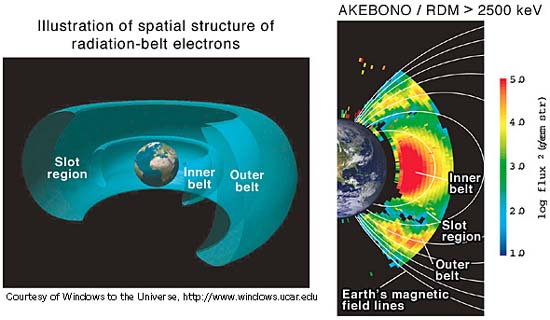Probabilistic Forecast of Killer Electron Alert in Geosynchronous Orbit
Dr Yoshizumi Miyoshi (Nagoya University) and Dr Ryuho Kataoka (RIKEN) have developed a forecasting system to predict the daily probability of a killer electron alert in geosynchronous orbits up to a week in advance.
The radiation belts (Van Allen belts) exist in the inner magnetosphere, and are composed of ions and electrons with an energy ranging from hundreds of keV to tens of MeV. The radiation belts consist of two zones, an inner belt and an outer belt. The outer belt lies at an altitude of 18,000 to 40,000 km where many satellites operate such as GPS satellites, meteorological satellites and communication satellites.
"Killer electrons" are high-energy electrons in the Van Allen radiation belts and they have an energy ranging from several hundred keV to tens of MeV (Figure 1). Deep dielectric charging occurs when high fluxes of killer electrons penetrate spacecraft shielding and imbed themselves in spacecraft dielectrics such as coaxial cables or circuit boards. Discharges and subsequent damage appear to occur after long periods of high fluxes. These effects have been demonstrated in the laboratory, and spacecraft problems during increased fluxes of these high-energy electrons are evident. It is still not clear, however, which, if any of the spacecraft failures, can be ascribed specifically to radiation effects.
It has been well known that the outer belt electrons tend to increase when there are high-speed solar winds. Miyoshi and Kataoka found that the flux enhancement depends on not only the solar wind speed but also on the sector polarity of the interplanetary magnetic field (IMF) and season. Also, they found that the high-speed solar wind associated with coronal holes is more effective for large flux enhancement on average than the high-speed solar wind associated with coronal mass ejections. They developed a combined algorithm for probabilistic forecasting the NOAA/SEC alert level of killer electrons in a geosynchronous orbit of more than 1,000 PFU.
The forecasting system uses real-time solar wind data from the ACE spacecraft located at L1 point to detect particular solar wind structures such as interplanetary shocks and stream interfaces, which are useful as a precursor of killer electron enhancement. Based on the solar wind speed, season, and magnetic field polarity, the daily percentage of killer electron enhancement after the precursor is calculated using data from the last ten years, and uploaded to the website (http://hbksw1.stelab.nagoya-u.ac.jp/). The probability forecast is displayed in three types of UFO icons where a fine weather picture signifies a 10-30% chance of killer electrons exceeding the alert level, while a cloudy picture signifies a 40-60% chance, and a rainy picture means there is a 70-90% chance (Figure 2). This probabilistic forecast system will be helpful for decision making from the point of view of a cost-loss model.
Dr Ryuho Kataoka, a special postdoctoral researcher at RIKEN, said "This forecasting system originated from a very similar concept to the weather forecast of precipitation probability. We will continuously investigate the characteristics of the solar wind and radiation belts in detail and hope to contribute to satellite operations."

Figure 1. Illustration of radiation-belt electrons (left). The spatial distribution of electrons above 2,500 keV observed by AKEBONO (right) with particles' flux expressed in color.
(http://www.isas.jaxa.jp/e/forefront/2006/miyoshi/index.shtml)

Figure 2. This table shows the probability that the 24-hour maximum value of 2MeV electrons in a geosynchronous orbit will exceed the NOAA/SEC alert level of 1,000 PFU. The forecast is updated every day by scientists between midnight and noon UT. "Today" means from midnight to the following midnight, UT.